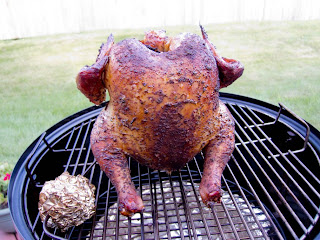I guess typically you’re supposed to enjoy a nice roast lamb
with some potatoes and vegetables, and use the leftovers for gyros. However, I
just went from point A to point C because gyros are amazing. Lamb recipe from: http://www.closetcooking.com/2012/04/greek-style-roast-leg-of-lamb-with.html
Lamb:
1 boneless leg of lamb (~3.5 lbs)
4 cloves garlic, sliced into slivers
Salt
Pepper
Rub:
1 tablespoon fresh rosemary, chopped
1 tablespoon fresh thyme, chopped
2 teaspoons dried oregano
1 teaspoon paprika
1 tablespoon dijon mustard
1 lemon
1/3 cup olive oil
Preheat your oven to 450°F
Pierce the lamb with a paring knife all over and stuff in
the garlic slivers. Season all around with salt and pepper.
Combine all the ingredients of the marinade in a bowl,
zesting the whole lemon and adding it to the bowl along with all the juice.
Stir to combine. Place lamb on roasting rack and apply rub.
Cover the roasting dish with foil, and bake for 1.5 to 2 hours,
until the meat reaches 115°F. Remove the foil, drop the oven to 350°F, and let
the meat brown, pulling it at 135°F. Let the meat rest before carving.
Tzatziki:
1 clove garlic
¼ very large cucumber, peeled and seeded
1.5 cups greek yogurt
½ tablespoon fresh dill, chopped
½ tablespoon fresh parsley, chopped
1.5 tablespoons lemon juice
Salt and black pepper to taste
Place the garlic clove, still in its sleeve, onto a cast
iron skillet and cook over medium for about 15 minutes, turning occasionally
until blackened in spots. Remove and let cool.
Dice the cucumber and place in a strainer set on top of a
bowl. Salt the cucumber and let sit for ½ an hour.
Remove the husk from the cooled garlic, dice it and add to a
bowl, along with yogurt, dill, parsley and lemon juice. Once the cucumber has
had its water drawn out, add it as well. Add salt and pepper to taste. Stir and
refrigerate until ready to use.
Gyro:
Pita
Butter lettuce
Tomato
Tzatziki
Roasted Lamb
Take your pita and put everything else on/inside it.































